Florenz – Stadtansichten. Foto Fratelli Alinari um 1870, erworben direkt bei Alinari um 1970: Kuppel und Campanile des Domes von Osten, Detail
Innerlich angeschlagen vom Tod meiner Frau Anfang 2024, ist im vergangenen Oktober ein einwöchiger Aufenthalt in Florenz für mich von großer Bedeutung. Ich fühle mich wohl in der Stadt, seitdem ich vor 60 Jahren dort mit meiner Dissertation begann und insgesamt fast 10 Jahre in ihr zuhause war.
Während dieser einen Woche habe ich eine große Zahl von Spitzenwerken der Malerei und Skulptur fotografieren können. Hiermit beginne ich die Veröffentlichung der Bilder.
Denken ist interessanter als Wissen, aber nicht als Anschauen.
Das schreibt Goethe in seinen Maximen und Reflexionen.
Florence – City views. Photo Fratelli Alinari around 1870, acquired directly from Alinari around 1970: Dome and campanile of the cathedral from the east, detail
In October 2024, a one-week stay in Florence is of great importance to me, as I am deeply affected by the death of my wife at the beginning of the year. I have felt at home in the city ever since I began my dissertation there 60 years ago and lived there for a total of 10 years. During this week I was able to photograph a large number of top works of painting and sculpture. Herewith I begin the publication of the pictures.
Goethe writes in his Maxims and Reflections: “Thinking is more interesting than knowing, but not than looking.”
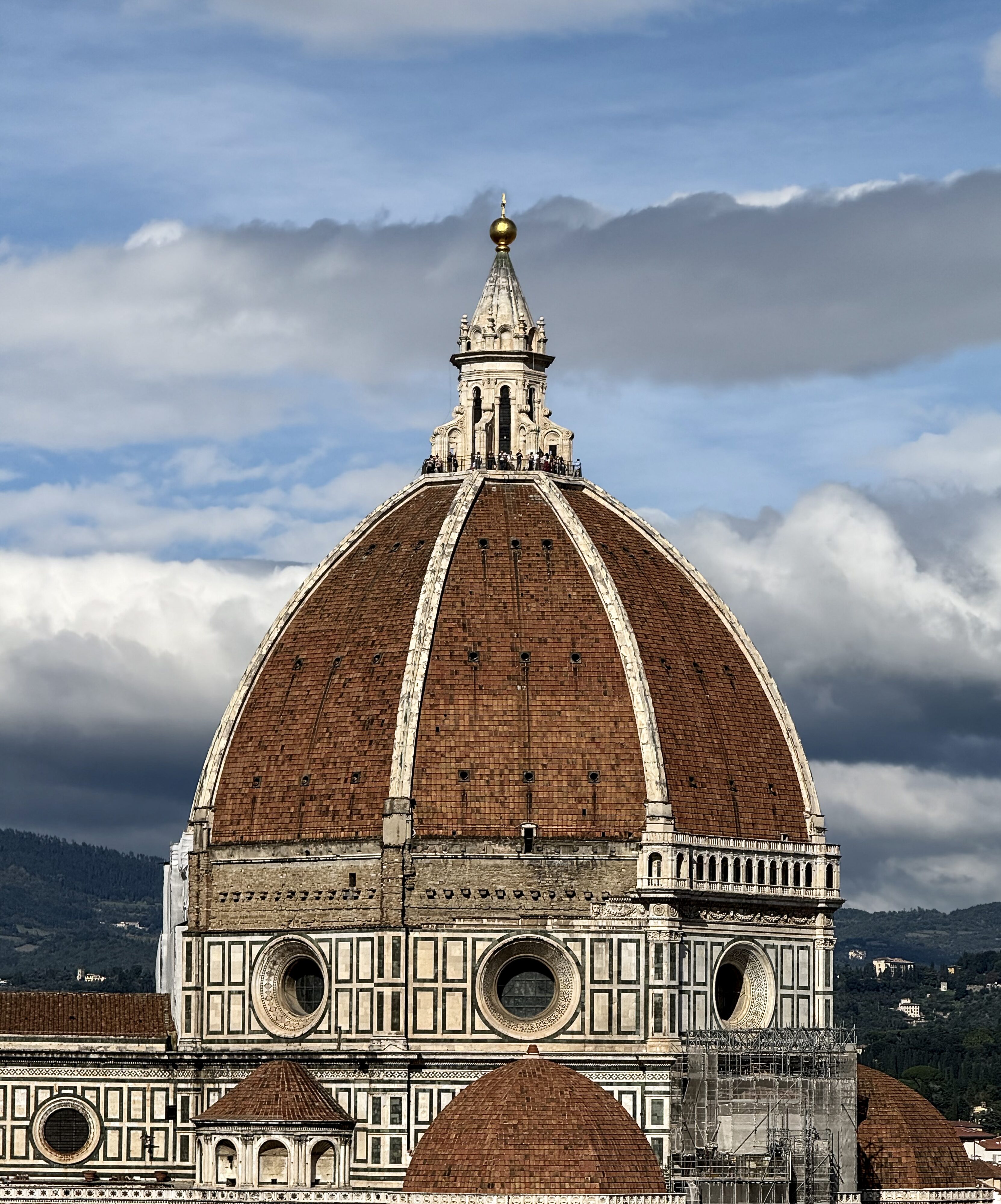
Ich starte mit dem Wahrzeichen der ganzen Stadt, der weltberühmten Kuppel des Domes von Filippo Brunelleschi.
I start with the landmark of the whole city, the world-famous dome of Filippo Brunelleschi’s cathedral.
Turmblicke vom Palazzo Vecchio
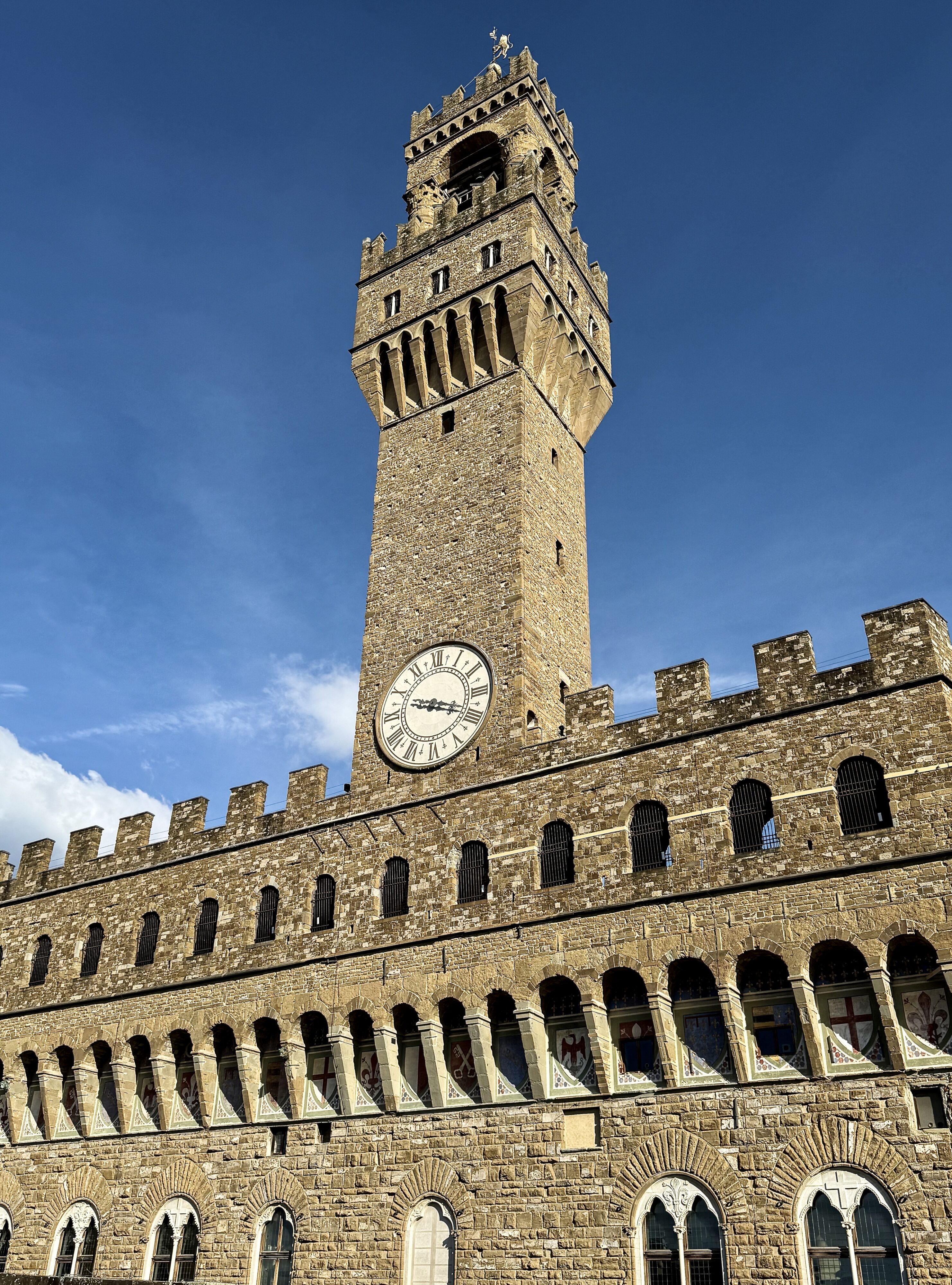
Die Blicke auf die Stadt stammen fast alle vom Turm des Palazzo Vecchio. Sie sollen der räumlichen Orientierung beim Aufsuchen der Kunstwerke dienen.
Den Türmer Lynkeus, dem ich mich sehr verwandt fühle, lässt Goethe in Faust II sagen:
Zum Sehen geboren,
Zum Schauen bestellt,
Dem Turme geschworen
Gefällt mir die Welt.
The views of the city are almost all from the tower of Palazzo Vecchio. They are intended to provide spatial orientation when visiting the works of art.
Florenz – Stadtansichten: der Norden der Stadt
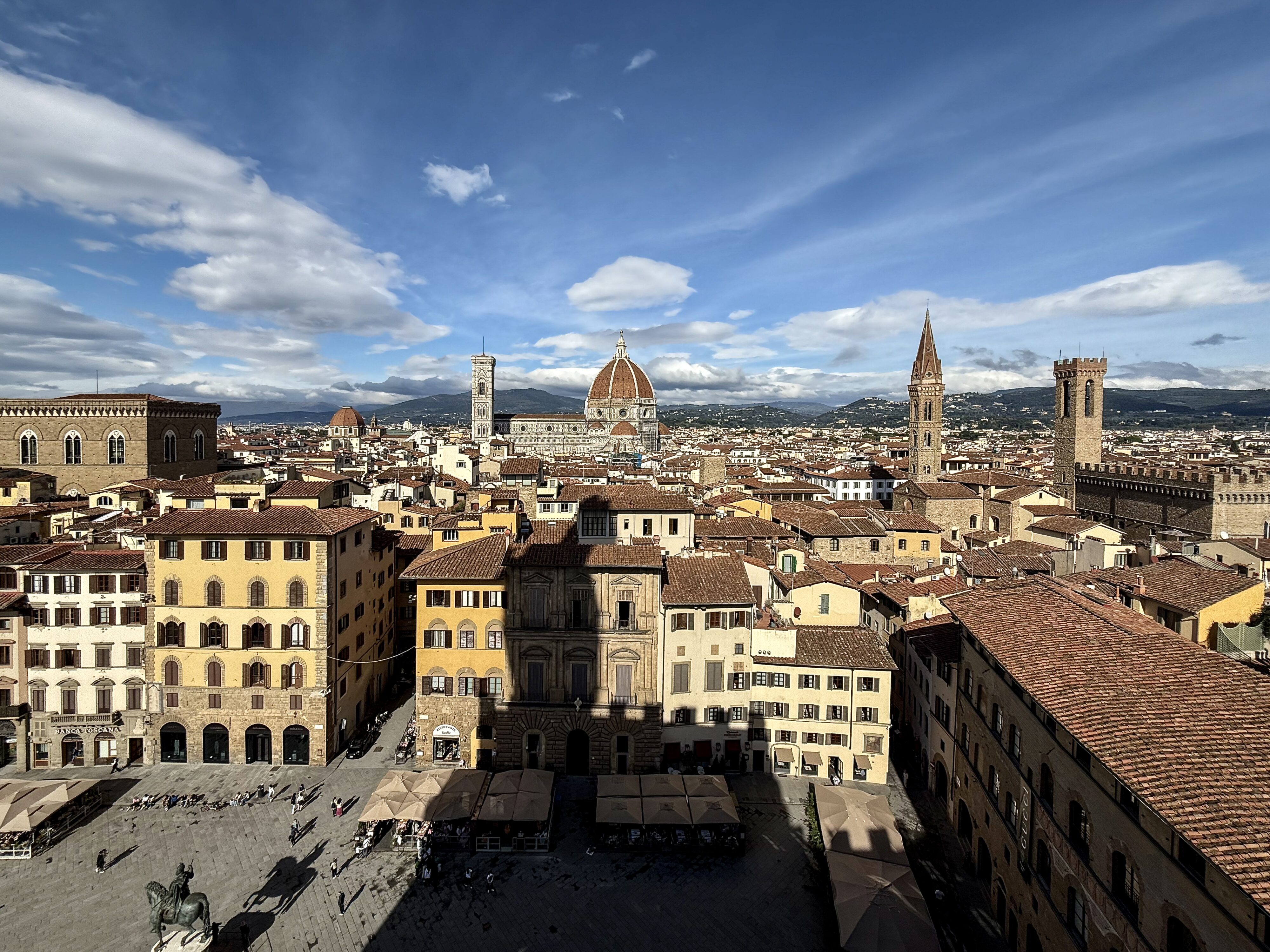
Blick vom Turm des Palazzo Vecchio auf die Piazza della Signoria in Richtung Norden. Von links das Dachgeschoss von Orsanmichele, die Kuppel der Cappelle Medicee als Teil von San Lorenzo, der Dom, der spitze Turm der Badia Fiorentina und die wehrhafte Architektur des Bargello.
View from the tower of Palazzo Vecchio to the north over Piazza della Signoria. From the left, the attic of the Orsanmichele, the dome of the Cappelle Medicee belonging to San Lorenzo, the cathedral, the pointed towerof the Badia Fiorentina and the fortified architecture of the Bargello.
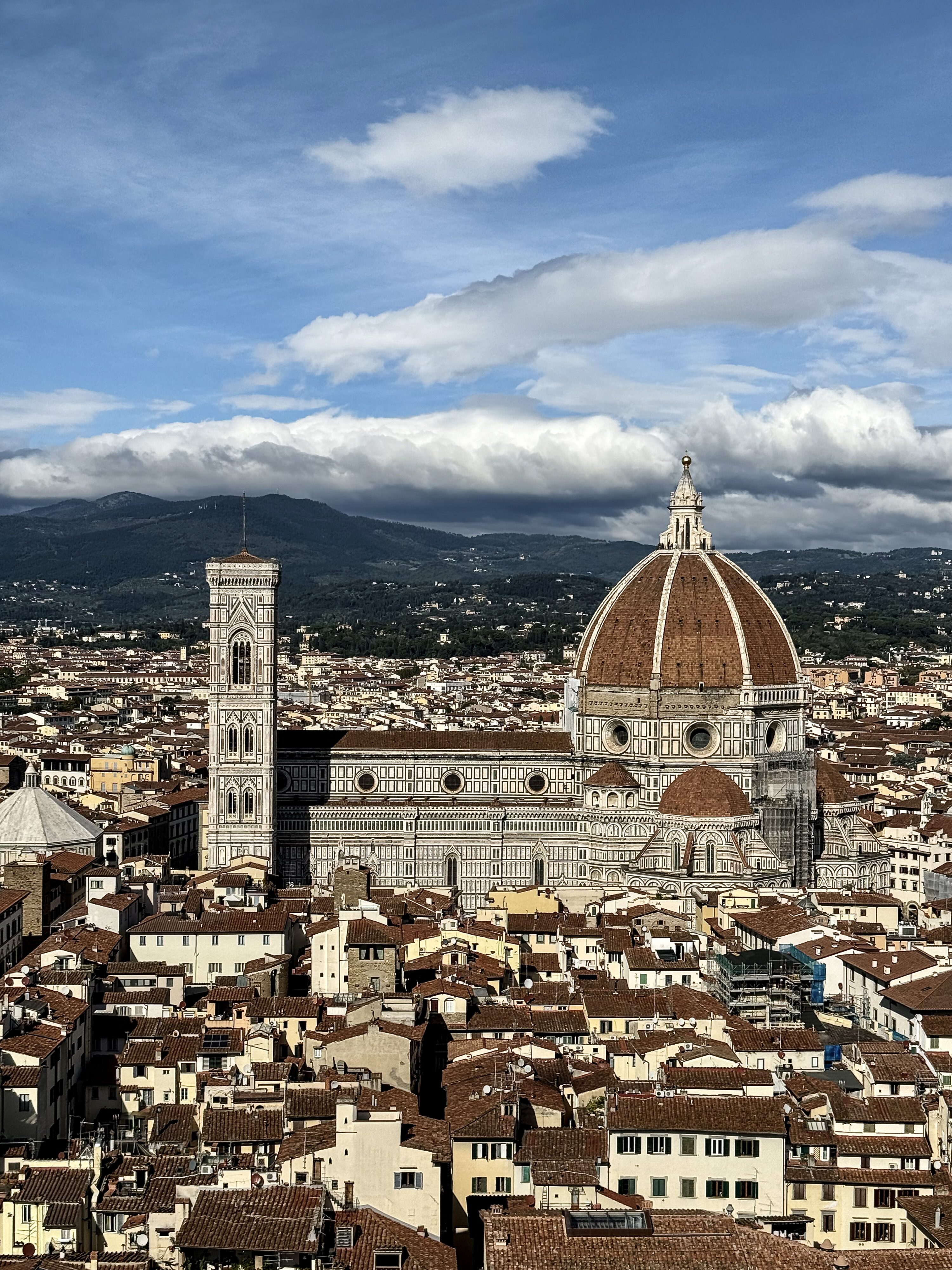
Die Kathedrale Santa Maria del Fiore wirkt wie eine Krone von Florenz. Der Stadtkern gehört zum Weltkulturerbe. Es gibt hier keinen modernen Bau, keine Werbung noch künstliches Licht über den Dächern. Links vom Campanile sieht man das Baptisterium.
The magnificent Cathedral of Santa Maria del Fiore looks like a crown on the city of Florence. The city centeris a World Heritage Site. There’s no modern construction, no advertisements, and no artificial lightingover the roofs. To the left of the Campanile, you’ll find the Baptistery.
Süden
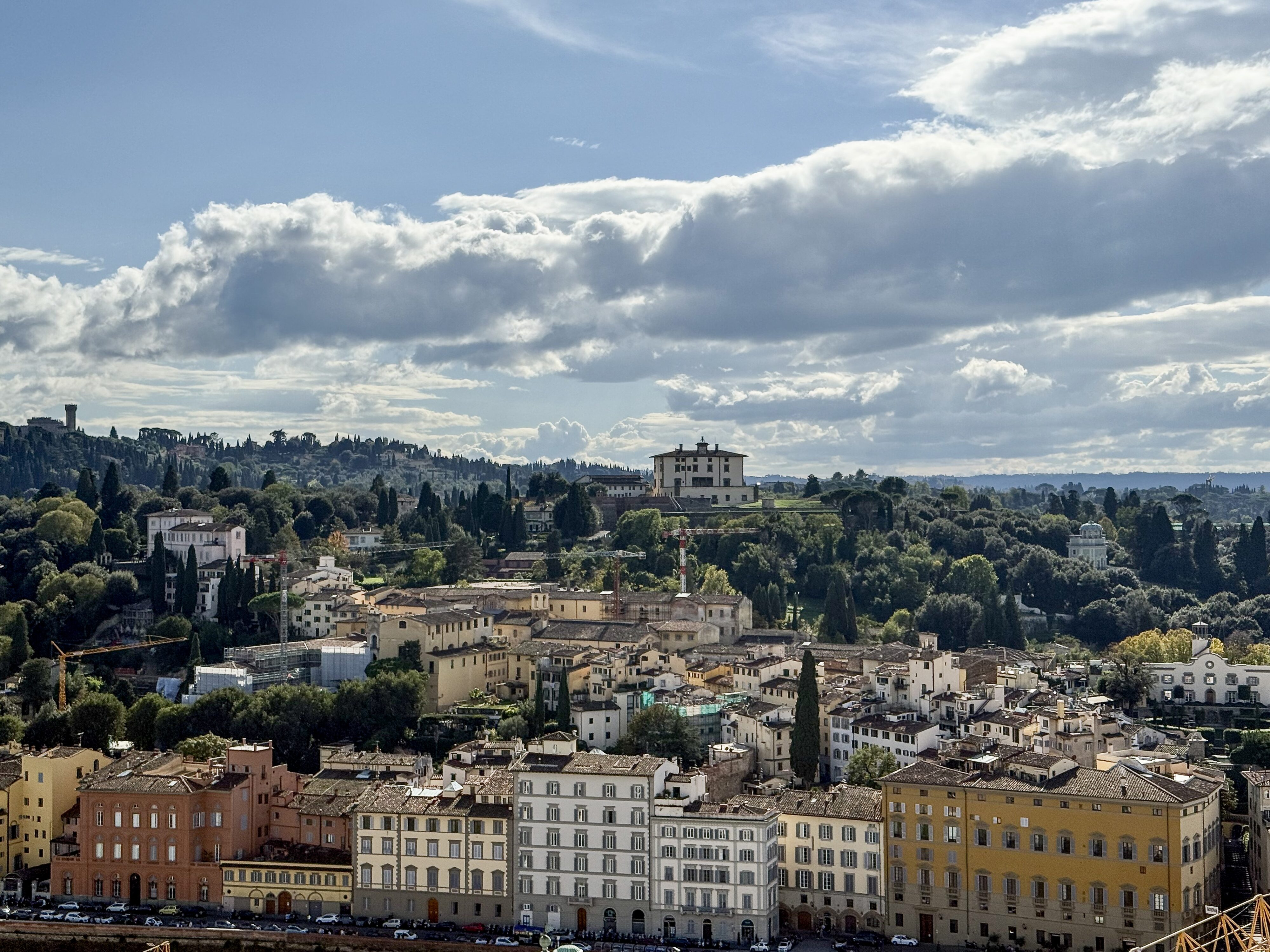
Blick nach Süden: jenseits des Arno ansteigendes Gelände. Von der Fortezza del Belvedere (= Schönblick) über dem Boboligarten bietet sich ein vergleichbar schöner Rundblick auf die Stadt wie vom Turm des Palazzo Vecchio oder der Domkuppel.
Turn south and you’ll find the terrain rises up beyond the Arno. From the Fortezza del Belvedere, which sitsabove the Boboli Gardens, you can enjoy a panoramic view of the city that rivals that from the Palazzo Vecchio tower or the dome of the cathedral.
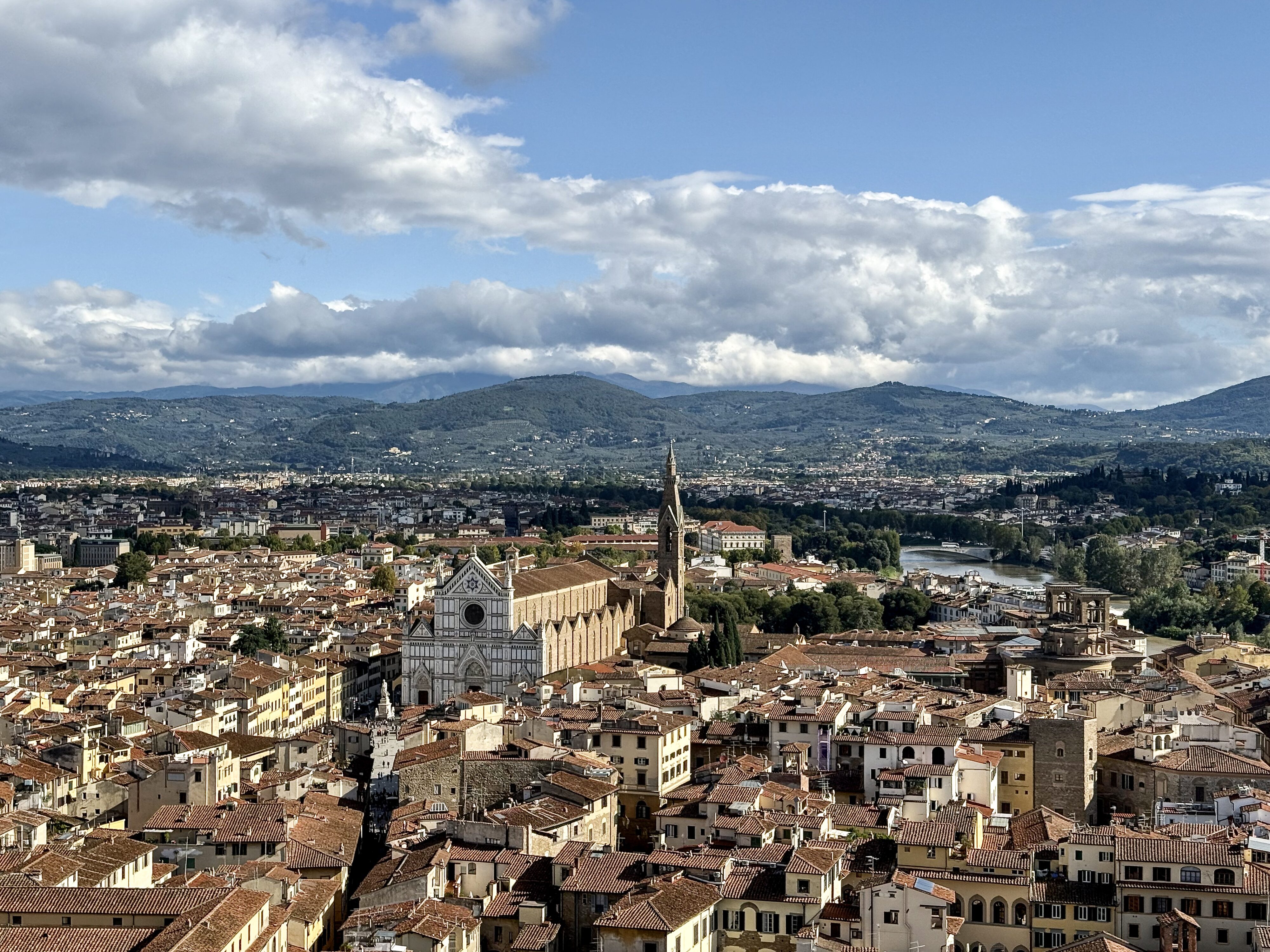
Im Osten dominiert die Kirche Santa Croce das Stadtbild. In der bewaldeten Hügellandschaft jenseits des Arno gibt es abgelegene Villen und kleine Ortschaften mit wunderbaren Fernsichten in Richtung Westen bis hin zu den Bergzüge um Carrara. Von dort stammt der weiße Marmor der meisten Skulpturen.
To the east, the church of Santa Croce dominates the cityscape. In the wooded hills on the other side of the Arno, there are secluded villas and small villages with wonderful views to the west as far as the mountain ranges around Carrara. This is where the white marble used for most of the sculptures comes from.
Florenz – Stadtansichten: der südwestliche Teil der Stadt
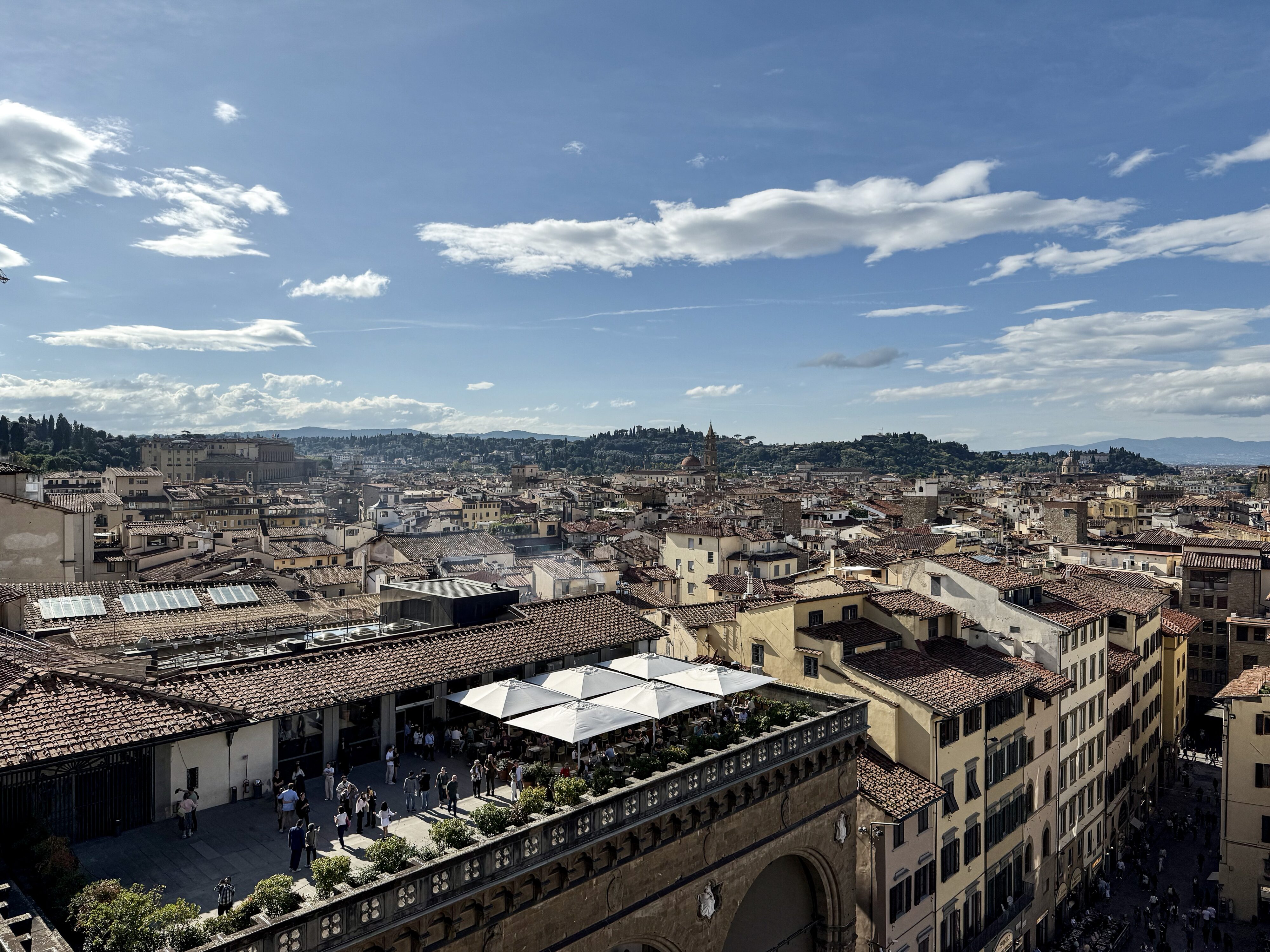
In Richtung Südwesten hat man vom Palazzo Vecchio zunächst die Dachterrasse der Loggia dei Lanzi vor Augen mit dem Café der Uffizien. Jenseits des Arno liegt das Viertel von Santo Spirito, dessen Kuppel und Turm in der Bildmitte schwach zu erkennen sind. In der Ferne sieht man die Höhenkämme des Chianti.
Looking southwest from Palazzo Vecchio. The first thing you see is the roof terrace of the Loggia dei Lanzi with the Uffizi café. On the other side of the Arno lies the district of Santo Spirito, whose dome and tower are faintly visible in the center of the picture. The ridges of the Chianti can be seen in the distance.
Der Arno, Fluss der Toskana
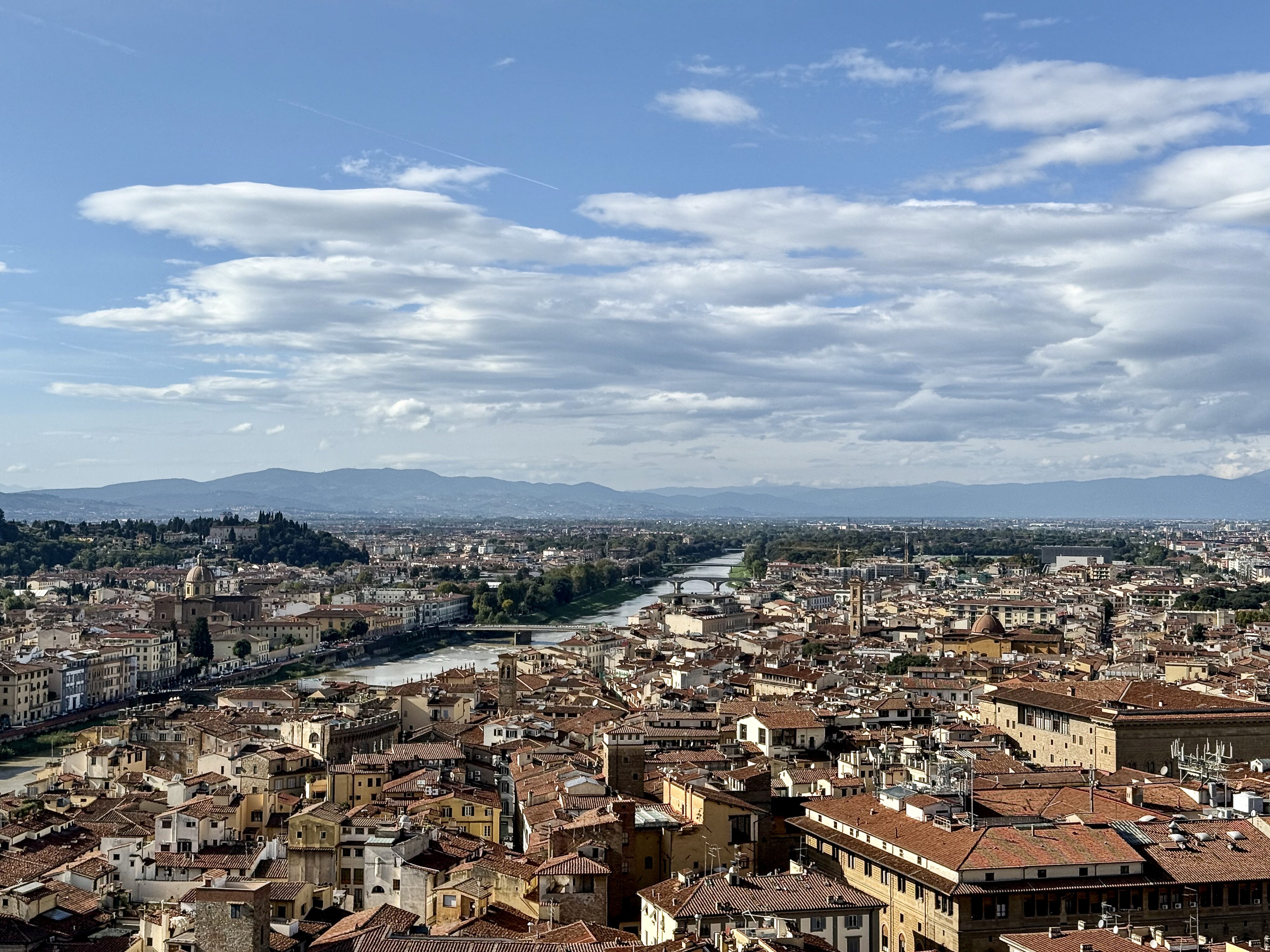
In Richtung Westen teilt der Arno die Stadt: links das Viertel Oltrarno (= jenseits des Arno) mit Santo Spirito. Hinter den fernen Höhenzügen liegt die Meeresküste.
To the west, the Arno divides the city. On the left is the Oltrarno district (= beyond the Arno) with Santo Spirito. Behind the distant hills lies the sea coast.
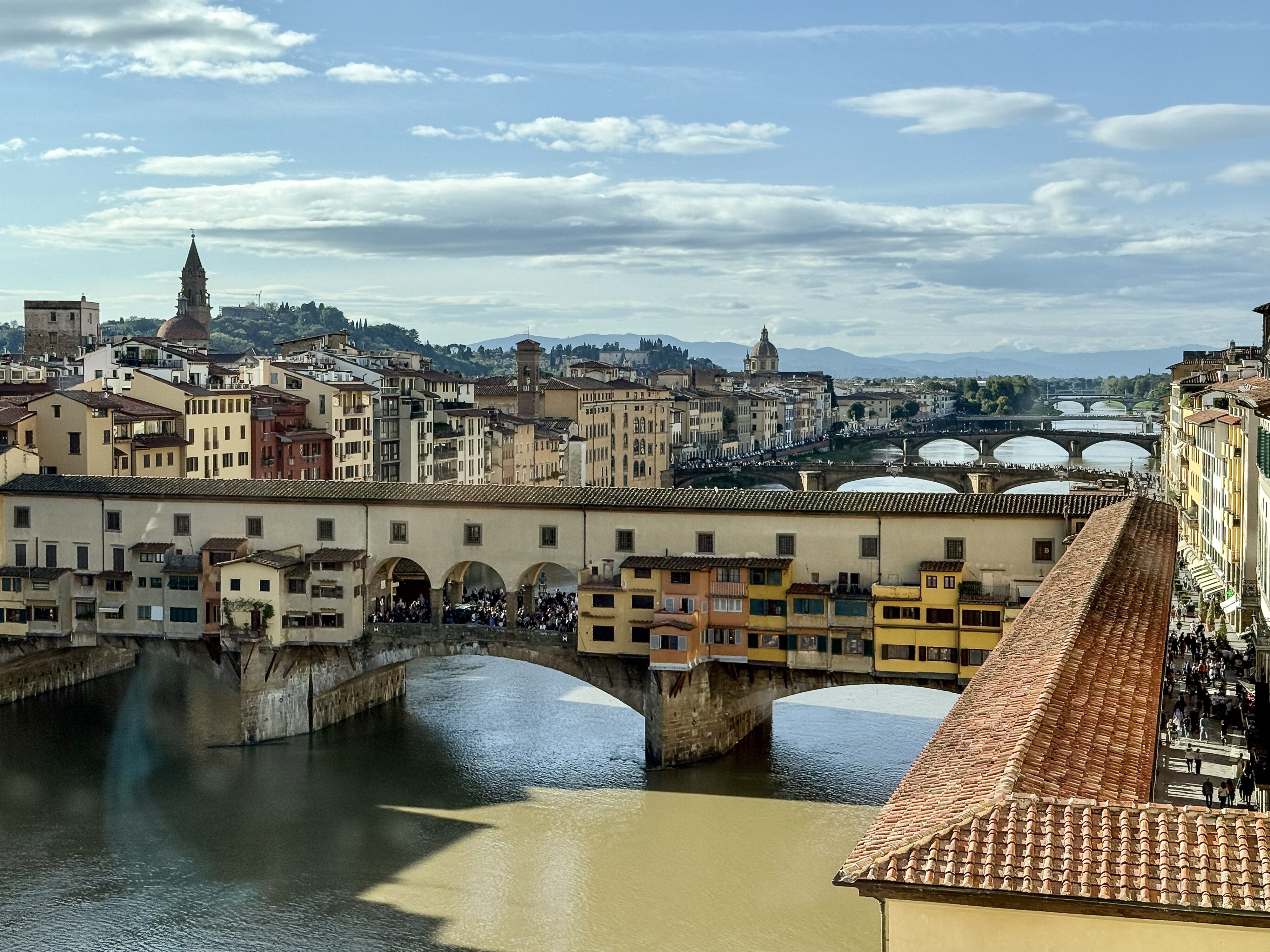
Ein Blick aus den Uffizien auf den Ponte Vecchio mit seinen Läden und darüber der Corridoio Vasariano. Flussabwärts folgen der Ponte alle Grazie und der Ponte alla Carraia. Links über den Dächern der Turm von Santo Spirito und in der Ferne die Kuppel von San Frediano in Castello.
A view from the Uffizi on the Ponte Vecchio with its shops and above the Corridoio Vasariano. On the left above the roofs the tower of Santo Spirito and in the distance the dome of San Frediano.
Das Wehr Pescaia di Santa Rosa
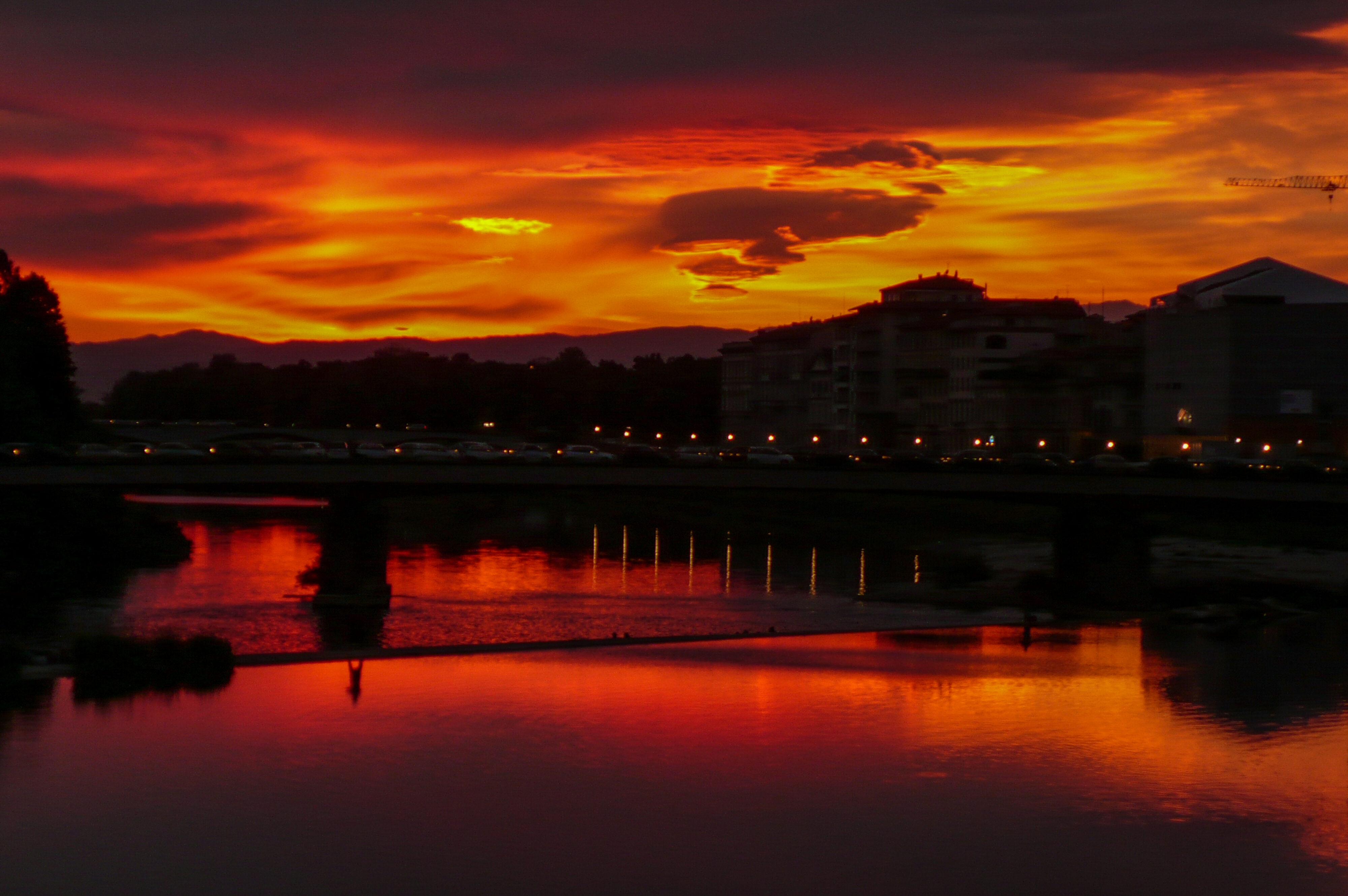
15. Mai 2015 um 20:43 Uhr: Blick vom Ponte alla Carraia flussabwärts. Als dunkle Linie zeichnet sich das Wehr Pescaia di Santa Rosa ab. Mönche der Kirche Ognissanti haben es im Mittelalter errichtet, um die Wasserkraft zu nutzen. Daher rührt die Ruhe der Wasserfläche vorne.
May 15, 2015 at 20:43: View downstream from the Ponte alla Carraia. The Pescaia di Santa Rosa weir can be seen as a dark line. Monks from the Ognissanti church built it in the Middle Ages to harness the power of the water. This is the reason for the tranquillity of the water in front.
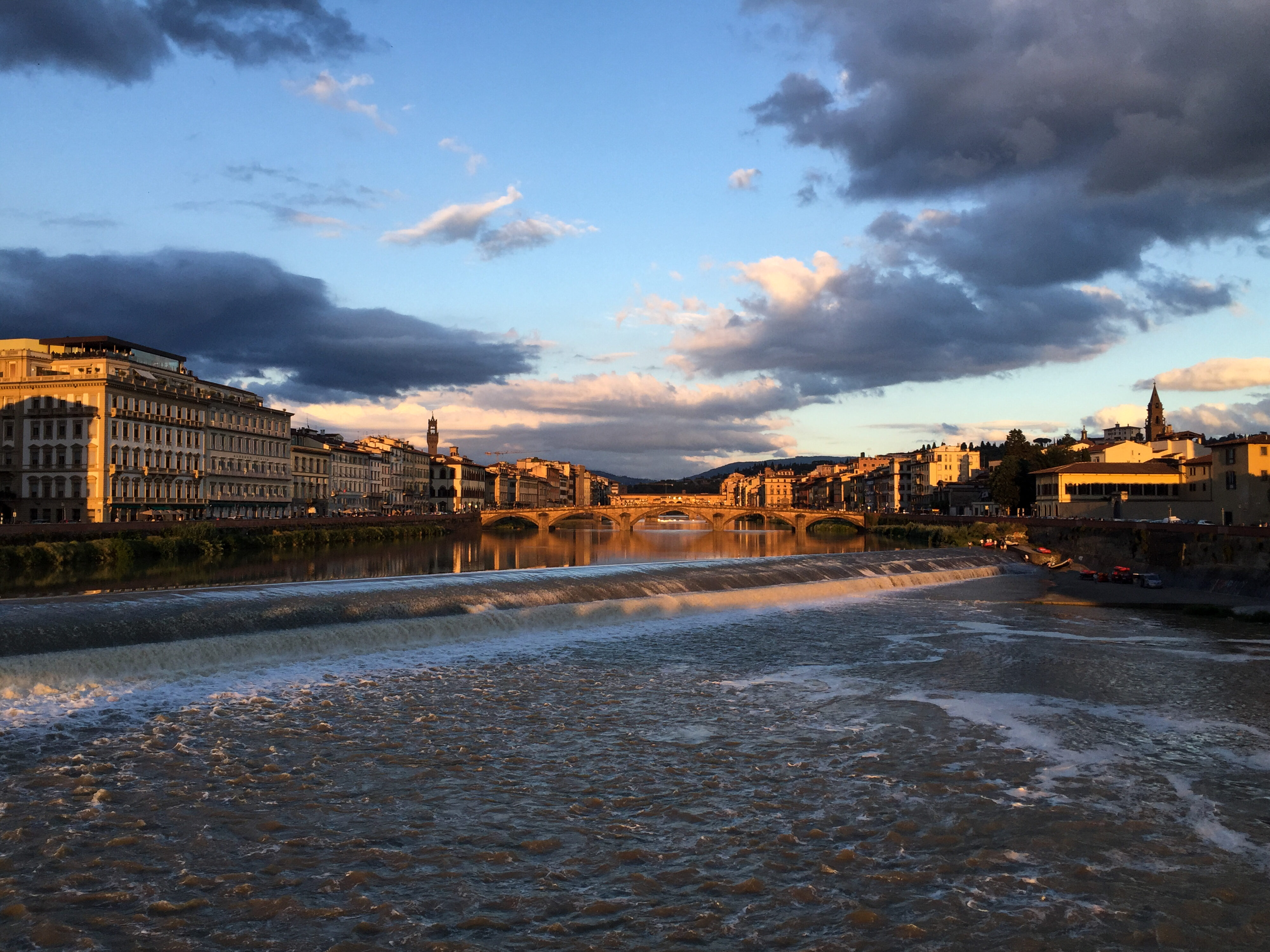
Blick am Abend vom Ponte Amerigo Vespucci in umgekehrter Richtung auf das Wehr Pescaia di Santa Rosa in der Nähe von San Frediano in Cestello, aufgenommen 2016.
View in the opposite direction in the evening from near San Frediano. Photo taken in 2016.
Florenz – Stadtansichten: ein Blick zurück

Florenz im 17. Jh. von Südwesten. Vorne das noch existierende Stadttor von San Frediano von 1332. Oberhalb davon das Wehr und die Ponte alla Carraia. Die Höhe über Oltrarno und dem Giardino Boboli gipfelt in der Festung Belvedere. Auf der nördlichen Seite des Arno das Stadtzentrum mit Dom. Noch ist die Stadt innerhalb der Mauern nicht ganz besiedelt, geschweige denn die Talflächen außerhalb.
Florence in the 17th century from the southwest. In front, the still existing city gate of San Frediano dating from 1332. The Belvedere fortress peaks above Oltrarno and the Giardino Boboli. On the northern side of the Arno is the city center with the cathedral. The city within the walls is not yet fully populated, let alone the valley areas outside.
Gibellina und die heilende Kraft der Kunst – ein kleiner Exkurs
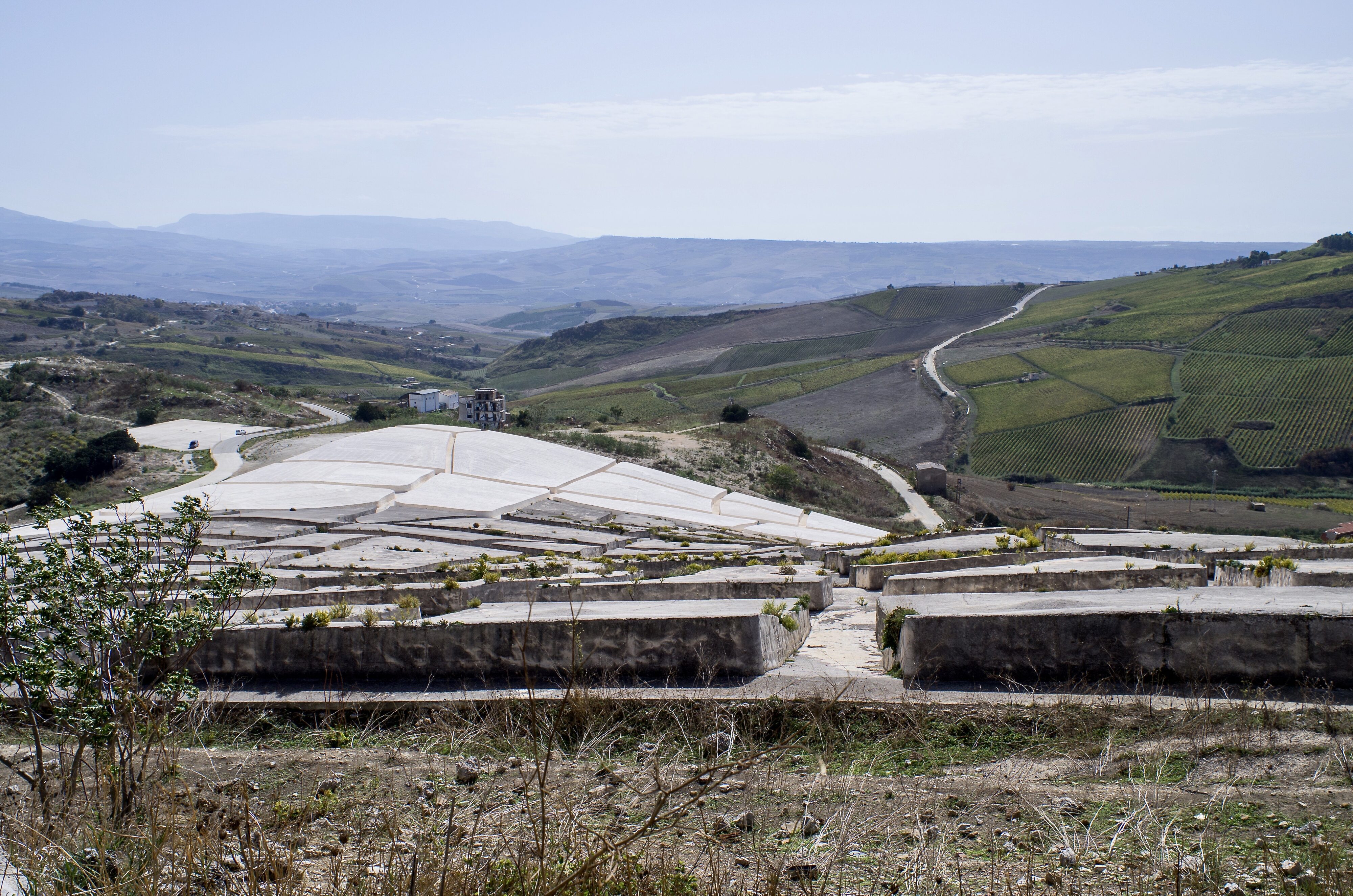
Gibellina Vecchia, eine abgelegene Örtlichkeit im Westen von Sizilien
Im Herbst 2016 verbringen meine Frau und ich mit unserem Freund und Trauzeugen Wilhelm Vossenkuhl, Philosoph an der LMU München, einige Ferientage bei Trapani. Auch er ist damals Witwer seit einem dreiviertel Jahr. Er führt uns nach Gibellina Vecchia, ein Dorf aus dem 14. Jh. Ein Erdbeben hat es 1968 ausgelöscht bis auf zwei Hausruinen.
Gibellina and the healing power of art – a brief digression and Der Künstler a remote place in the west of Sicily
In the fall of 2016, my wife and I spent a few days on vacation in Trapani with our friend and best man Wilhelm Vossenkuhl, a philosopher at the University of Munich. He had also been a widower for three quarters of a year at the time. He takes us to Gibellina Vecchia, a village from the 14th century. An earthquake destroyed it in 1968 except for two ruined houses.
Wilhelm Vossenkuhl in Gibellina
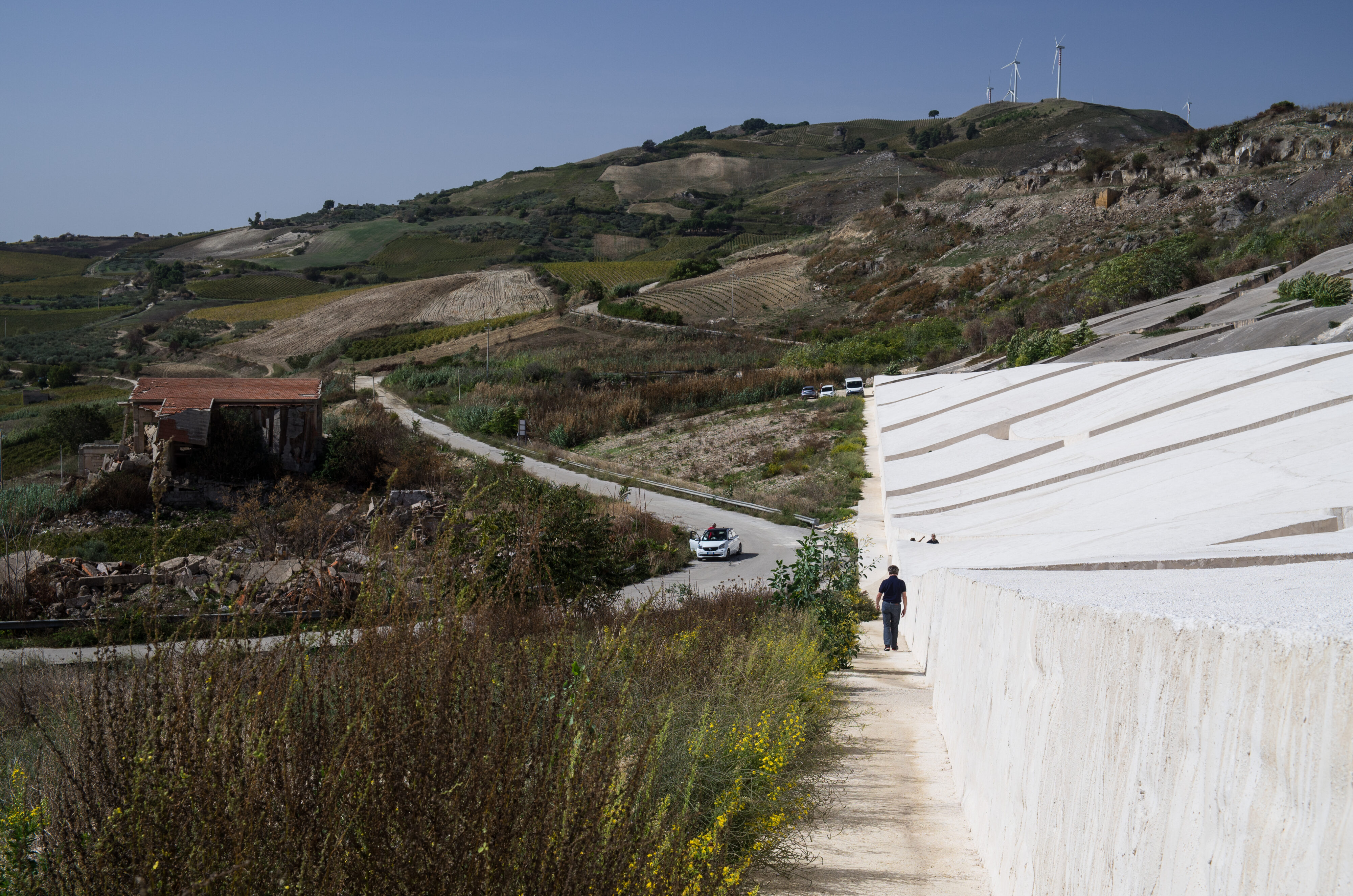
Wilhelm Vossenkuhl am 13. Oktober 2016 im ehemaligen Gibellina. Der Künstler Alberto Burri hat die Fläche des Dorfes mit Beton zugedeckt und dabei die alten Gassen als Wege erhalten. Er hat Gibellina in eine Art monumentales Grab verwandelt und ein weltweit einzigartiges Kunstwerk geschaffen. Wir sind dort allein.
Wilhelm Vossenkuhl on October 13, 2016 in the former Gibellina. Alberto Burri has covered the area of the village with concrete, preserving the old alleyways as paths. He has transformed Gibellina into a kind of monumental tomb, creating a work of art that is unique in the world. We are alone there.
Der Hauch der Kunst

„COSA SAREBBE L’UOMO SENZA IL SOFFFIO RIGENERATORE DELL‘ ARTE ?“ Das steht auf einer der beiden Hausruinen. „Was wäre der Mensch ohne den wiederbelebenden Hauch der KUNST?“. Das durfte ich bei meinem Aufenthalt in Florenz und dem Wiedersehen mit altvertrauter Kunst erfahren.
“What would man be without the revitalizing breath of ART?”. I was able to experience this during my stay in Florence and the reunion with familiar art.

Lieber Christian – es ist schön, auf Deinen und Ingas Spuren durch Florenz zu wandern – es frischt auch meine eigenen Erinnerungen auf.
„What would man be without the revitalizing breath of ART?“ Mir spricht dieser Satz aus dem Herzen.
Mit lieben Grüßen von Deiner Richild
Lieber Christian,
Was für schöne Ansichten von Florenz! Herzlichsten Dank dafür. Deine Erinnerung an unsere gemeinsame Reise nach Gibellina Vecchia hat mich sehr berührt.
Herzlichsten Dank!
Dein Willi